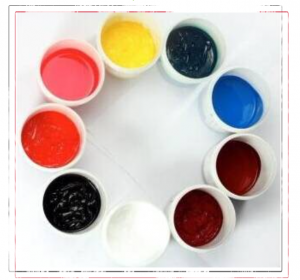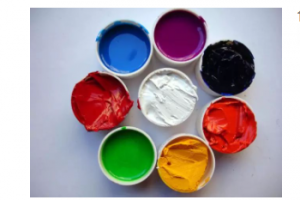Analysis of defects of flat screen and circular screen printing
Flat (round) screen printing defects, varied, people grouped it into several types, when the finished product inspection to distinguish, according to the phenomenon named. In fact, the defects are rarely reoccurring, although the same phenomenon, but not necessarily the same reason. Here, the most common defects are analyzed, and it is not possible to include every kind of defects. It is also just a possibility of fault analysis, to provide a kind of analysis of fault ideas.

1、Pressing paste: flower pattern outline is not clear, compound color contact surface blur
A. Causes:
a. pressure will only paste, wet cover wet printing, the latter version of the pressure paste before a version.
b. The pressure at the mouth of the receiving plate more times pressure paste serious.
B. Solutions
a. Receive pulp to clear, choose the right scraper (hardness).
b. When available, the distance between the version and the version, if necessary, the middle heating blowing.
c. Correctly arrange the position of the screen cylinder or flower plate.
d. In the flat screen printing when dealing with the flower draft open road as little as possible in and out.
e. The flower frame edge for filler processing.
2、Glue edge: fabric side channel pressure paste

A. Causes:
a . Blank fabric width is not flush, first narrow and then wide or patching is not in the same line, so that the round, or flat screen screen version of the two ends of the pulp printed to the guide, and then stick to the next round or behind the screen, and then printed to the next version of the fabric edge, resulting in paste edge.
b . The edge absorber is out of order, and the edge of the incoming cloth is not in a straight line.
c . The width of the round mesh or flat mesh after sealing the edge is greater than the width of the blank cloth.
B. Solutions:
a . Rearrange the blank, machine printing into the cloth width of the same width. Both ends of the screen according to the width of the cloth seal and printing position sealing edge.
b . Paste the cloth from the side of the guide equal distance, not drift.
c . Squeegee scraping width is at least 5cm greater than each side of the fabric seal.
d . Suction edge device good intact.
3, open: flower-shaped outline blurred, the color of the pattern to the fiber direction penetration
A. Causes:
a. The guide belt cleaning scraping water is not dry, the blank is attached after the watermark.
b. Low viscosity of color paste, dyestuff concentration is very thick, too much printing sizing or moisture-absorbing agent dosage, the original paste holding water poor.
c. Printing before drying after washing, causing the first few editions to open.
d . The surface water after washing the net cylinder is not dragged evenly
B. Solutions:
a . Check the guide with water washing box scraping device is good.
b . Select the paste with good water holding capacity. Check that the process prescription dosage is reasonable (the saturation amount of dyes, the amount of additives), and the paste should not be set aside for too long.
c. Blow dry the flower plate after washing before use.
d . Net cylinder down before the need to use a sponge mop to mop evenly.
4, scraping into: different color pulp is scraped into, the formation of color light is not right uneven

A. Causes:
a. The dark color flower block surface with more pulp.
b. Flat net column edge is not good, the pulp from the guide belt into the flower version
B. Solutions: a. Under the conditions that do not affect the color reproduction
a. Under the condition of not affecting the compound color, change the position of the flower plate.
b. As far as possible according to the width of the fabric to stop good flower plate position.
c. Pulp collection net, diligent addition of pulp.
5, the box printed: flower pattern near the mouth of the joint plate presents the abnormal stripes in the shape of the frame of the flower plate
A. Causes:
a. poor installation of the screen frame, the height is not the same.
b. The gap between the screen plate and the guide belt is too small.
B、Solution: a. The screen frame can be raised slightly:
a. The screen frame can be slightly raised.
b. Correct open circuit when dealing with flower shape.
6, a version of the color difference (scraping unevenly or in the fabric of the horizontal presentation of a certain interval of color shades)
A, the cause.
a . Screen or round net photopolymer thickness is not uniform, flower exposure is not uniform, production problems.
b . Screen frame is not in the same plane, or poor installation.
c . Squeegee is loose or scraping the print jump.
B. Solutions:
a . Make a new stencil or round screen from scratch. If it is film-sensitive, the quality of the film must also be checked.
b . The screen frame is pressed flat, but when printing, observe whether the flower shape is out of shape.
c . Install the stencil with the same height at both ends.
d . Squeegee installation in place.
7, joint plate printing: joint plate at the color has a shade of embossing or overlap or to open
A. Causes:
a . Guide belt running back to the position is not allowed.
b . Squeegee left and right pressure is not well adjusted.
c . The screen frame is too high from the guide belt, and the screen is found to be off on the side when scraping.
d . Flower-shaped open circuit size is too large.
B. Solutions:
a . According to the flower shape back to set the guide belt running back, or check whether the guide belt operation is normal.
b . Scraper pressure adjustment to just under the pulp appropriate.
c . Adjust the height of the stencil.
d . The back of the stencil can be partially lined with a fine screen with a large gap. Modify the unreasonable open circuit.
8, ding flower (tube) version: uneven shades of flowers with daisy-like hair
A. Causes:
Flower version raised (screen tube rolled over) when the color paste is pulled up, the reverse side of the flower version stained with color paste, affecting the next version of the scraping printing
B. Solutions:
a. The viscosity of the flower paste is not suitable.
b. The old pulp is filtered and used again or replaced with new pulp.
c. Timely wash the flower plate (screen tube)
9, flower: flower position at the exposed blank color or poor permeability, such as sand fish epidermis shape of the flower spot
A. Causes:
a. Flower plate (screen tube) plug brake.
b. Improper choice of scraper or pressure is too small, not enough under the pulp.
c. There are oil stains, wax, etc. on the blank fabric.
d. Before the set of flowers is not dry, the reverse side of the set of flowers (screen tube) sucked up.
B. Solution:
a. Flower plate (screen tube) should be cleaned every time.
b. Choose a good scraper, force appropriate.
c. To test the capillary effect, if necessary, the blank re-training.
d. Flat net in the front and back of the set of plates under the conditions of appropriate distance.
e . Color paste viscosity is not appropriate.
f . The mesh of the screen (round mesh) is not properly selected.
10, coarse and fine stems: fine stem thickness is not uniform
A. Causes:
a. Stencil (screen cylinder) production has thick and thin defects.
b . Magnetic table of the left and right magnetic size is not the same. Generate different printing pressure caused by.
c. The screen plate is not flat.
d. The pressure of the squeegee left and right is inconsistent, the knife is not flush, and the thickness of the squeegee mouth is inconsistent.
e. Scrape printing pulp collection is not net.
B. Solutions:
a. Carefully check the flower plate (screen cylinder).
b. Check the magnetic force of the magnetic table size.
c . Stencil flattening.
d . Choose a good squeegee and adjust the pressure on board.
e. Switching squeegees should be consistent.
f . Adjust the height of the screen cylinder according to the thickness of the fabric.
Translated with www.DeepL.com/Translator (free version)

